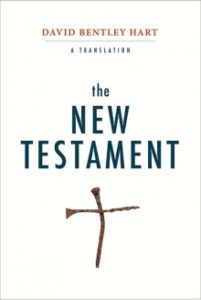
The New Testament: A Translation
David Bentley Hart. The New Testament: A Translation. New Haven, CT: Yale University Press, 2017, 616 pp. $35.00.
Reviewed by Matthew A. Smith
In attempting to translate the Bible, the most frequent norm is ‘translation by committee,’ wherein a number of scholars settle upon the most agreeable renderings, and disagreements are handled by democratic process. Enter David Bentley Hart and his translation of the New Testament. By contrast to this approach, Hart has no interlocutors and no committees; instead, he alone translates the New Testament in its entirety from its various manuscripts (albeit not without reference to scholarly consensus). He writes, “I have come to believe that all the standard English translations render a great many of the concepts and presuppositions upon which the books of the New Testament are built largely impenetrable . . . . I [am] opposed to translation by mass collaboration on principle [… because] all such renderings, it seems to me, become ineluctably mired in the anodyne blandness and imprecision of ‘diplomatic’ accord” (xv).
In many respects, this approach is refreshing. The New Testament is a diverse collection of texts written by multiple authors in a variety of literary genres, ranging from ecclesial letters to historical accounts and from poetry to parable. Hart’s translation preserves the idiosyncratic nature of each author’s voice. He does so without any attempts to ‘smooth over’ the oddities in their writing, which would produce a Bible that reads in a more unified but less authentic tone. Hart’s translation, sometimes ‘rough around the edges’ and sometimes downright poetic, yield a finished product that recaptures the eccentricities of the original Greek text. Hart also provides useful explanatory footnotes laden with scholarly resources, including notes of manuscript histories, word usages, and linguistic nuances. Certain notable examples include his treatment on Junia (317), an explanation of the implications of ‘violence’ in Luke 16:16 (145-6), women’s silence in the church in 1 Corinthians 14 (345), and the word ‘antichrist’ in 1 John 2 (481-2). His postscript contains detailed expositions of certain Greek words and their history of appearances and meanings in various texts, explaining his choices to translate them in certain ways.
In other places, however, Hart’s utterly literal approach to the text can lead to some odd results. Consider the way he renders John 1:14: “And the Logos became flesh […] and we saw his glory, glory as of the Father’s only one” (169). Hart’s choice to render monogenēs as “the Father’s only one” surely adheres to his mission to leave behind doctrinal commitments, and is not without its share of comparative translations such as in the NIV or the ESV. However, some may consider rendering monogenēs as anything besides “only-begotten” to be a particularly theologically declarative move, no matter how much controversy the concept of Christ’s divinity may have engendered historically. Indeed, Hart spends considerable time defending his choices about the Johannine prologue. Lexically, there is some ambiguity as to whether monogenēs necessarily entails only-begottenness, since (1) it comes from genos rather than gennaō, and (2) it is used in Hebrews 11:17 to denote Isaac’s relationship to Abraham, and Isaac certainly is not the only child Abraham begat. Still, Hart’s literally faithful reproduction may indeed fail the litmus tests of theological stringency for some readers who are not fully on board with his translative philosophy. Given his approach, however, his dedication to the absence of theologically-interpretive decisions wherever possible is unsurprising: he remarks that he is attempting to shake loose the fetters of “doctrinal expectations that have shaped the decisions of translators for centuries” (xv). However, some may consider his renderings to make theological declarations all their own.
Another important question concerns the audience of the book. Hart frequently explains to readers his choices via footnotes (or his postscript) on a level which seems to assume an absence of familiarity with the field of biblical studies, which suggests that his volume may have been produced with an audience of laity or perhaps moderately-educated clergy in mind. However, his translations and footnotes frequently employ words which the vast majority of readers in such categories would find unfamiliar. His use of terms such as farraginous, euphony, chiliarch, and maladroit are unremarkable to those in his field or in educated circles, but are likely to be lost on a lay audience, thereby leading one to wonder who the intended audience is. He seems to desire the raw natures of the New Testament texts to be accessible for those whose facilities in ancient languages do not match his own. However, this mission may be undermined by Hart’s linguistic propensity for using English equivalents of hapax legomena that only scholarly readers would digest without pause. This vocabularistic predilection combined with Hart’s now-trademark acerbic wit may be disconcerting for lay readers, further calling into question the volume’s intended audience.
These matters, while pertinent, do not detract for the most part from the pleasure of reading Hart’s translations. In his introduction, Hart opines that this text is not produced for liturgical reading or for literary eloquence; and yet, his rendering of the New Testament is still a delight to read, and brings a joy to scriptural reading unparalleled by other translations of late. A number of translation decisions may at times hamper his renderings for some readers. Furthermore, all but the most bitterly sarcastic observers may find an apparent trenchant derision in some of his explanatory annotations or introductory notes, which may be particularly rebarbative to lay readers. Still, Hart has done excellent work in providing this translation. Pastors preaching from his work will find the scripture enlivened with new vigor, and laity reading it may find new spiritual insights for old verses thought to be worn entirely threadbare. I recommend Hart’s translation of the New Testament to anyone who wishes to see the Scripture in a new light.
Matthew A. Smith, Th.M., M.A. Princeton Theological Seminary; Part-Time Faculty, Lee University
